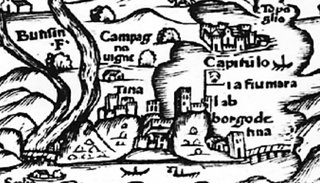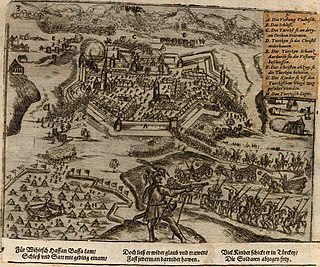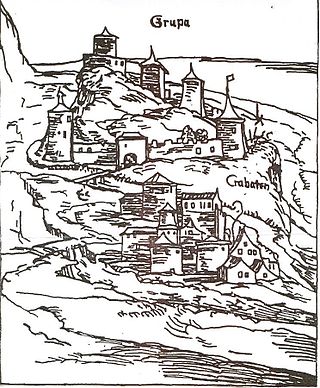See also
- Bihać operation, the military operation from World War II in Yugoslavia
Siege of Bihać may refer to:

Bihać is a city and the administrative centre of Una-Sana Canton of the Federation of Bosnia and Herzegovina, an entity of Bosnia and Herzegovina. It is situated on the banks of river Una in northwestern Bosnia and Herzegovina, in the Bosanska Krajina region. In 2013 its population was 56,261.

A series of military conflicts between the Ottoman Empire and various European states took place from the Late Middle Ages up through the early 20th century. The earliest conflicts began during the Byzantine–Ottoman wars, waged in Anatolia in the late 13th century before entering Europe in the mid-14th century with the Bulgarian–Ottoman wars. The mid-15th century saw the Serbian–Ottoman wars and the Albanian-Ottoman wars. Much of this period was characterized by the Ottoman expansion into the Balkans. The Ottoman Empire made further inroads into Central Europe in the 15th and 16th centuries, culminating in the peak of Ottoman territorial claims in Europe.

Nagykanizsa, known colloquially as Kanizsa, is a medium-sized city in Zala County in southwestern Hungary. It is a city with county rights.

Bosanska Krajina is a geographical region, a subregion of Bosnia, in western Bosnia and Herzegovina. It is enclosed by a number of rivers, namely the Sava (north), Glina (northwest), Vrbanja and Vrbas. The region is also a historic, economic and cultural entity of Bosnia and Herzegovina, noted for its preserved nature and wildlife diversity.
The military history of Croatia encompasses wars, battles and all military actions fought on the territory of modern Croatia and the military history of the Croat people regardless of political geography.

The Long Turkish War, Long War, or Thirteen Years' War was an indecisive land war between the Habsburg Monarchy and the Ottoman Empire, primarily over the principalities of Wallachia, Transylvania, and Moldavia. It was waged from 1593 to 1606, but in Europe, it is sometimes called the Fifteen Years War, reckoning from the 1591–1592 Turkish campaign that captured Bihać. In Turkey, it is called the Ottoman–Austrian War of 1593–1606.
The military history of the Republic of Venice started shortly after its founding, spanning a period from the 9th century until the Republic's fall in the 18th century.

Operation Summer '95 was a joint military offensive of the Croatian Army (HV) and the Croatian Defence Council (HVO) that took place north-west of the Livanjsko Polje, and around Bosansko Grahovo and Glamoč in western Bosnia and Herzegovina. The operation was carried out between 25 and 29 July 1995, during the Croatian War of Independence and the Bosnian War. The attacking force of 8,500 troops commanded by HV's Lieutenant General Ante Gotovina initially encountered strong resistance from the 5,500-strong Army of Republika Srpska (VRS) 2nd Krajina Corps. The HV/HVO pushed the VRS back, capturing about 1,600 square kilometres of territory and consequently intercepting the Knin—Drvar road—a critical supply route of the self-declared Republic of Serbian Krajina (RSK). The operation failed to achieve its declared primary goal of drawing VRS units away from the besieged city of Bihać, but it placed the HV in position to capture the RSK's capital Knin in Operation Storm days later.

The siege of Scutari, also referred to as the siege of Shkodër, known in Turkish as İşkodra Müdafaası(in Turkish) or İşkodra Savunması, took place from 28 October 1912 to 23 April 1913 when the army of the Kingdom of Montenegro defeated the forces of the Ottoman Empire and invaded Shkodër.
Conquest, Capture or Siege of Tunis may refer to:

The siege of Bihać was a three-year-long siege of the northwestern Bosnian town of Bihać by the Army of the Republika Srpska, the Army of the Republic of Serbian Krajina and Bosnian Muslim dissenters led by Fikret Abdić during the 1992–95 Bosnian War. The siege lasted for three years, from June 1992 until 4–5 August 1995, when Operation Storm ended it after the Croatian Army (HV) overran the rebel Serbs in Croatia and northwest of the besieged town.

The siege of Gvozdansko was an Ottoman siege of the fort of Gvozdansko in the Kingdom of Croatia in 1577–1578. In the 1570s, the Ottomans intensified their efforts to capture the valley of the Una River. A string of forts along the Una, centred around Gvozdansko and in possession of the Zrinski noble family, formed the main line of defense of Croatia since 1527. The fort held off Ottoman attacks in 1540 and 1561.

The Split Agreement or Split Declaration was a mutual defence agreement between Croatia, the Republic of Bosnia and Herzegovina and the Federation of Bosnia and Herzegovina, signed in Split, Croatia on 22 July 1995. It called on the Croatian Army (HV) to intervene militarily in Bosnia and Herzegovina, primarily in relieving the siege of Bihać.

The siege of Knin was a siege of the city of Knin, the capital of the Kingdom of Croatia, by the Ottoman Empire in 1522. After two failed attempts in 1513 and 1514, Ottoman forces led by Ghazi Husrev Bey, sanjak-bey (governor) of the Sanjak of Bosnia, launched a major offensive on southern Croatia in the spring of 1522. In May, his forces, reinforced with troops from the Sanjak of Herzegovina and Constantinople, besieged the Knin Fortress.

The siege of Bihać was the besieging and capture of the city of Bihać, Kingdom of Croatia within Habsburg monarchy, by the Ottoman Empire in June 1592. With the arrival of Hasan-paša Predojević as the Beylerbey of the Bosnia Eyalet in 1591, a period of peace established between Emperor Rudolf II and Sultan Murad III ended and the provincial Ottoman armies launched an offensive on Croatia. Bihać, a nearly isolated city on the Una River that repelled an Ottoman attack in 1585, was one of the first targets. Thomas Erdődy, the Ban of Croatia, used available resources and soldiers to protect the border towns, but the Ottomans managed to take several smaller forts in 1591. As the offensive gained pace, the Croatian Parliament passed a law on a general uprising in the country on 5 January 1592.

The siege of Krupa was fought on 3–23 June 1565 between the Ottoman forces of Mustafa Pasha Sokolović, sanjakbey of Bosnia, and the Germanic and Croatian forces led by Matija Bakić. The siege was a part of the Croatian–Ottoman wars and Ottoman–Habsburg wars between the Ottoman Empire and the Habsburg monarchy.
Sieges of Vienna may refer to:

The Bihać operation was a military operation conducted by Yugoslav partisans against the Independent State of Croatia (NDH) and Nazi Germany during World War II. The aim of the operation was to capture Bihać and the surrounding towns to connect Partisan held areas in Bosanska Krajina, and Knisnka Krajina. The battle for the city of Bihać lasted from 2 November to 4 November 1942. After capturing the city, the partisans continued to fight in surrounding areas until 15 November. The operation resulted in a major Partisan victory, with Bihać and the surrounding areas being captured, and the NDH suffering significant casualties.

The Great Turkish War of 1684–1689 saw conflict between the Holy League and the Ottoman Empire in territories of Croatia, Slavonia and Dalmatia. The war was concluded by the Treaty of Karlowitz in 1699, which significantly eased the Ottoman grip on Croatia.

Siege of Bihać (1697) was a Habsburg siege of the Ottoman fortress town of Bihać in Bosnian Krajina. The siege was planned as a diversionary attack from main Habsburg offensive on Danube river, and was called off after several failed storming attempts.